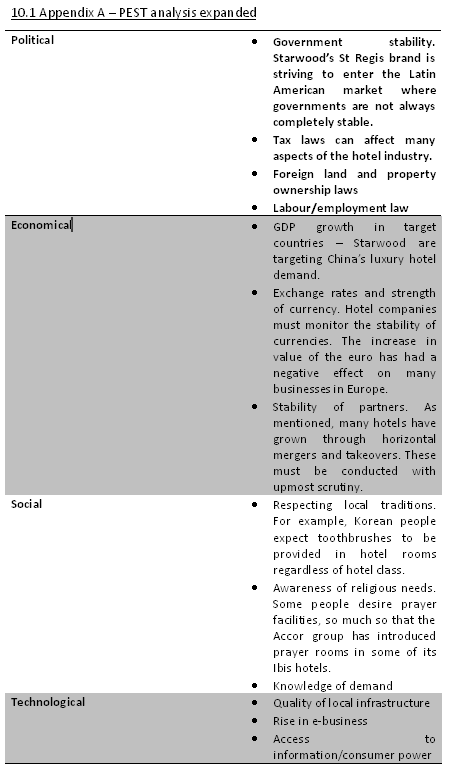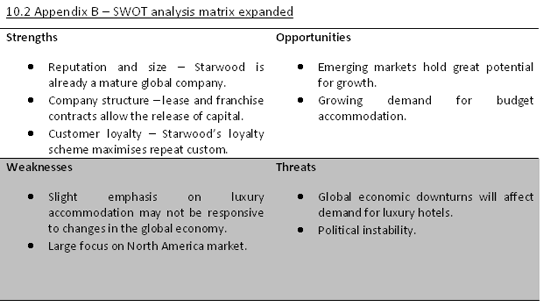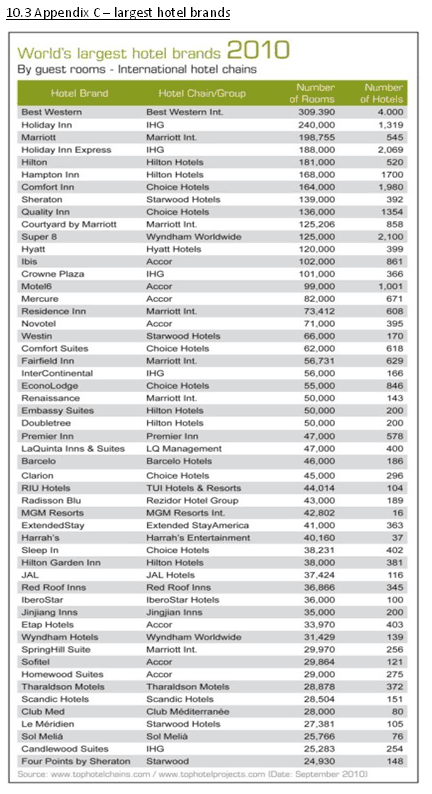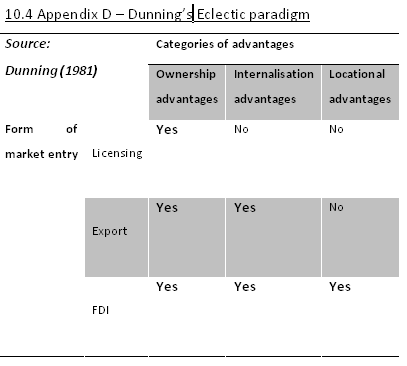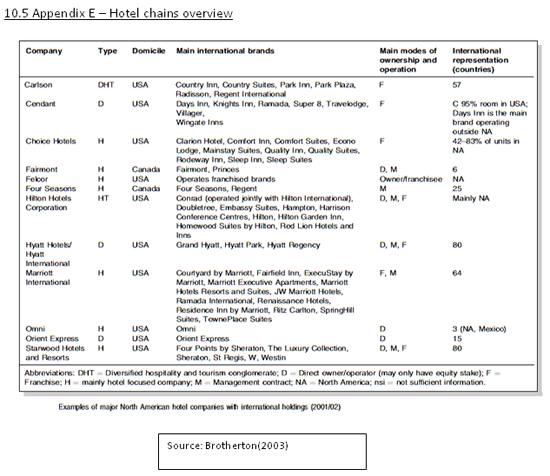Sector report: hospitality industry
INTRODUCTION
The Tourism and Hospitality Sector is one of the largest industries in the world, although it is difficult to put an exact value on the hotel sector due to its sheer size. However, Thomas (2007) states that the UK Tourism and Hospitality industry alone is worth over £100 billion. It is also one of the fastest growing industries with a constantly changing dynamic. Therefore firms strive to differentiate to deliver a clearly defined experience that differs from competitors (Bowie, 2004). This is one of the major issues facing the market leaders in the hospitality sector and one which will need to be addressed to maintain future competitiveness.
The focus of this report is to synthesise and critically analyse the hospitality sector. Firstly, a sector overview will be carried out to determine the state of the industry. Then there will be environmental scanning using theories such as LEPEST and SWOT analysis, which will aim to indicate the concerns that the companies in this sector face. Next, Michael Porter’s Five Forces model will be examined, which will emphasise the key factor of competition. Following on from that, there will be a section on business format and internationalisation concepts and credentials where attention will be given to certain companies’ strategies and analyses of their performance. Then the report will carry out a portfolio analysis making use of the Boston Consulting Group Matrix in order to highlight the positions of companies within the industry. Finally, there will be a quantitative analysis of the financial performance of the sector, rounding off with an overall conclusion.
2. Sector Overview
2.1 Global Hospitality Sector Overview
Hospitality provides food, water and shelter – the essential physiological means by which to live, according to Maslow (1943) (see appendix A), thus indicating the overall importance of the hospitality sector and its core purpose. With growing demands for travel and leisure over the past century, the industry has rapidly expanded with the prominence of globalisation. Clarke (2007) argues that the sector has been split into many identifiable sectors each with its own needs. This report will concentrate on the hotel sector.
2.2 Hotel Sector Overview
The hotel sector consists of a small number of large multinational companies (Brotherton, 2003). These large MNEs often have several brands with are marketed at different consumers. These MNEs have often grown horizontally through takeovers and acquisitions of existing hotel chains. The hotel sector comprises of luxury hotels, budget hotels, business accommodation and leisure accommodation, and many more aspects.
3. Environmental Scanning
3.1 What is Environmental Scanning?
A hotel is not just a building; it is an entity which can be affected by a million different actions at any one time. These can be categorised to an extent by change, complexity, constraints and conflicts (Go, 1992). Using theoretical frameworks allows these vast happenings to be analysed and acted upon by company management to gain and maximise competitive advantage.
3.2 PEST Analysis of the Hotel Industry
PEST analysis is a key tool for evaluating issues at macroeconomic level. Keegan (1974) recognised long ago that executives rely heavily on external sources of information about their business environment (see figure in the appendix). Here are some of the key issues facing the Starwood Group.
3.2.1 Political
Companies within the hotel industry are often required to invest large amounts in the form of foreign direct investment (FDI). This already is a large barrier to market entry, however, and local property laws can have huge impact. Starwood are currently constructing hotels in China. However, private land ownership is impossible so land can only be leased.
3.2.2 Economical
Emerging markets such as China and the Middle East are driving demand for tourism. Below shows the GDP growth rate for China: after inflation adjustments strong growth levels of over 10% (Choi, 2003). Choi (2003) regards the significance of GDP as a key indicator to environmental scanning for companies. With increasing wealth comes extra demand for hotels both domestically and internationally for leisure and business purposes. This is important to an extent, but other factors such as exchange rates and currency valuations are worth noting.
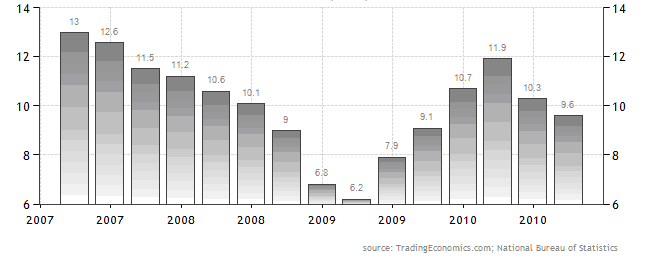
Figure 1: China’s GDP
3.2.3 Social
Reuland (1985) explored the socio-cultural differences in regards to the hotel industry and warned that western-style hotels will not be fully successful in the East without adapting to their culture. However, some hotel chains have had success without making changes to their rooms. Starwood also recognised this and source local ingredients and provide native-style meals in hotel restaurants throughout the Middle East and Asia. Many companies in the industry are also recognising customers’ demands are evolving; for example, Starwood operate the St Regis brand, specialising in provide hotel services in unique locations such as French Polynesia.
3.2.4 Technological
The most prominent feature is the rise in communications. Global distribution systems (GDSs) and Computer Reservation Systems (CSRs) mean consumers now have access to information and the ability to find the exact hotel based on budget, location, facilities etc. (Hayes, 2010). Hayes (2001) notes that the top 16 companies in the hotel industry work together to reduce the costs of these systems. Arguably the key feature is correct utilisation of this system in order to maximise profits. It also encourages vertical integration with airlines to provide a smoother service for customers. This still puts great pressure on hotels to set fair and competitive prices and also promote their own brands using the medium of the Internet.
3.3 SWOT Analysis
SWOT analysis refers to ‘Strengths’, ‘Weaknesses’, ‘Opportunities’ and ‘Threats’ and works together with PEST analysis to provide a static viewpoint of the current environment. Strengths and weaknesses are internal factors that management must control in the long term (Walker, 1996). While opportunities and threats may not be controlled directly, it is vital to maximise the opportunities and minimise the weaknesses. Alone, it may be argued that SWOT is a little simplified, this is further argued by Armstrong (1981), who proposes a five-step plan to expand upon SWOT. In this report, the PEST analysis acts as that five-step plan. Here, we will look closely at the Starwood Group and scan their environment.
3.3.1 Strengths
Starwood have a number of strengths that support the company’s position as a global leader. Firstly, they have very clearly defined brands which has enabled them to gain a huge market share. St Regis, W, Westin, Le Meridien, Sheraton are strong brands marketed worldwide. A further strength of Starwood and what is common amongst many hotel groups is the structuring of franchise agreements. Starwood sold off many of its owned hotels and concentrated on contracts, franchising and leasing. This has freed up enormous amounts of capital for Starwood, which has enabled it to reinvest this revenue in strengthening other aspects of the Group.
3.3.2 Weaknesses
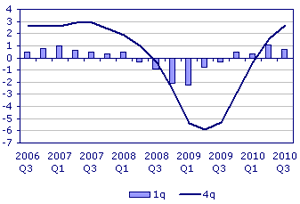 Figure 2: UK’s GDP. Starwood has a strong focus on luxury hotels. This leaves them vulnerable to potential global economic slowdowns, with evidence suggesting that demand for budget travel accommodation is increasing. The UK’s leading budget hotels, Premier Inn and Travelodge had room revenue increases of 9.2% in 2008 at a time when the UK’s economy was starting to experience a decrease in growth (Langston, 2008).
Figure 2: UK’s GDP. Starwood has a strong focus on luxury hotels. This leaves them vulnerable to potential global economic slowdowns, with evidence suggesting that demand for budget travel accommodation is increasing. The UK’s leading budget hotels, Premier Inn and Travelodge had room revenue increases of 9.2% in 2008 at a time when the UK’s economy was starting to experience a decrease in growth (Langston, 2008).
3.3.3 Opportunities
Because of the international nature of the hospitality industry, there is always scope for overseas growth. Starwood are currently trying to seize the opportunity presented by emerging markets around the world. Countries such as India and China are developing rapidly and demand from their growing middle classes presents a massive opportunity. Starwood’s then chairman, Barry Sternlicht, was quoted as saying: “We can’t move fast enough in China”.
3.3.4 Threats
There are a number of threats to the hospitality industry: economic slowdowns, terrorism, environmental concerns; increasing fuel prices will all have an effect on demand for travel. Starwood’s brand portfolio is weighted towards luxury hotels and the current economic downturn has impacted on consumption. Travellers taking three or more luxury breaks per year fell by 15.1% in 2009 (Mintel, 2010).
3.4 Five Forces Analysis
Porter’s (1998) competitive analysis was developed to build upon SWOT analysis that Porter believed to be “unrigorous and ad hoc” (Porter, 2002). It provides an insight into the relationships and dynamics of an industry (Van Assen, 2008). So we can use Porter’s framework and apply it to the hospitality industry.
3.4.1 The threat of the entry of new competitors
Due to the size of the major companies in the industry, any small independent firm will face huge barriers to entry. Without significant levels of capital it would be almost impossible to survive when trying to compete with a company such as Starwood or Hilton. These chains carry large economies of scale in marketing and branding as well as within the supply chain, enabling the big companies to minimise costs. Therefore the threat to these companies from new entrants is very low.
3.4.2 The threat of substitutes
Hotels do have a degree of price inelasticity especially for the business consumer. However, according to Mintel, 65% of people regard price as the main influence upon their choice (Mintel, 2010). Location is second on the list with 43% indicating that price and location of accommodation are more important than the room itself. The goal of any hotel firm should be to retain custom through loyalty and membership schemes.
3.4.3 The bargaining power of customers
As there is no large single buyer, the power of the consumer is relatively low (Olsen, 1998). This concurs with the fact that the majority of hotel customers are individuals for either business or leisure purposes. It may be argued that with the increase in technology, consumers have access to more information and are able to compare hotels on the basis of price and location much more easily than in the past.
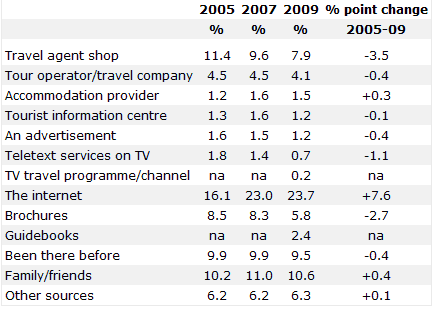
The above chart shows an increasing trend in Internet usage and further supports the point that increasing knowledge is increasing power.
3.4.4 The bargaining power of suppliers
Large hotel companies have enormous power when negotiating for supplies. The cost for the hotel chain of changing supplier is relatively low; supplying companies have to compete heavily to win contracts for major chains. This leaves almost no scope for bargaining and heavily favours the hotel chains. This is a further example of the economies of scale experienced by the larger companies.
3.4.5 Competitive rivalry within the industry
Sharpe (1990) noted that in the coming years the global environment would open and new markets would emerge. At the time, he cited Russia and China, and he was correct. Hotel chains aim to compete on location and these emerging markets can be highly lucrative. For example, Starwood especially aim to develop in new exotic locations, but are beginning to face competition from local businesses, especially in the Middle East. Hotel giants aim to compete on price and even more so on non-price levels; quality of restaurants, membership benefits, luxury and locations are marketed above price.
3.6 Summary
Hotel giants have a great deal of power when bargaining with customers and suppliers. Although consumers are gaining a little power, they do not have a large scope to negotiate on room prices directly. Furthermore, the difficulty of entering the market means that the main companies in the top-heavy industry will continue to prosper.
4. Internationalisation
4.1 What is Internationalisation?
“Internationalisation is taken to mean any form of transaction by an enterprise outside its national boundaries, in which assets, rights or goods are transferred and there is some continuing de facto control over the use of these and, or complementary indigenous resources” (Dunning, 1981). Dunning’s definition is a rather broad concept, so in this section we will look at how hotel chains have grown internationally.
4.2 Why Internationalise?
Increasing personal incomes and the availability of mass short- and long-distance travel are two reasons why hotel firms seek to invest abroad (Brotherton, 2003). This demand is a motivation for hotel companies to expand in order to maximise profits and experience economies of scale. Knowles (1998) notes that the emergence of the Southeast Asian economy is beginning to influence the hotel sector in a large way and 12 years after this research it is clearly evident that many hotel chains are looking to benefit from the high demand in these economies. The Starwood Group are evidence of this as they plan to open 26 hotels in India by 2013 (Hotel Management Asia, 2010).
4.3 How to Internationalise
Below is an example of the internationalisation of the Starwood Group:
Table 2: Starwood’s history
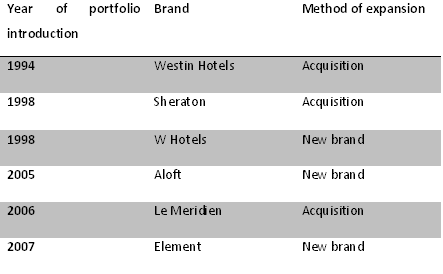
It is clear to see that the majority of its growth has come through acquisition of other chains. This form is beneficial as there is already little product differentiation and the acquired companies already have renowned brands and reputations allowing Le Meridien and Sheraton to fit into the business profile without the need for radical changes to the running or physical aspects of the hotels. This fits Dunning’s Eclectic paradigm (Dunning, 1981) under Ownership Advantages, where the trademark adds value to the overall company profile.
Table 3: Starwood’s St Regis brand internationalisation
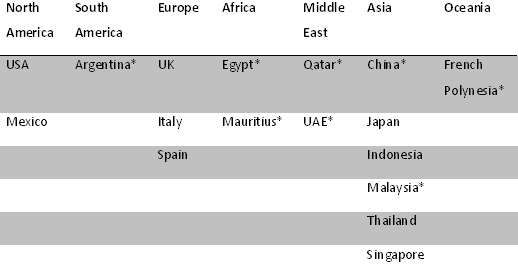
The strategy taken by Starwood St Regis is to internationalise by expanding of markets, rather than trying to grow market share in the highly competitive North American and European markets.
5. Key Sector Financial Indicator Analysis
Financial analysis is a way of managing several aspects of the financial side of the company, including operating capacity, profitability, and debt-paying ability whilst comparing the balance sheet and profit and loss account (Alexander, 2008).
5.1 Revenue Analysis
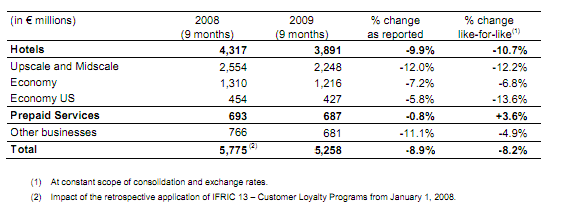
Table 4: Accor revenues 2008-2009

Table 5: Starwood revenues 2008-2009
The above charts illustrate that both companies witnessed decreasing revenues of 8.2% and 18.1%, respectively. The reasons cited by Starwood for their huge decrease was the continuing financial crisis in the USA, where it has 533 hotels located (Starwood, 2009). Economic factors are also to blame for the downturn in Accor’s revenue. At times of economic troubles consumers search for a budget alternative. Below are the revenue figures for Whitbread plc which operates Premier Inn in the UK.

Table 5: Starwood revenues 2008-2009
The above charts illustrate that both companies witnessed decreasing revenues of 8.2% and 18.1%, respectively. The reasons cited by Starwood for their huge decrease was the continuing financial crisis in the USA, where it has 533 hotels located (Starwood, 2009). Economic factors are also to blame for the downturn in Accor’s revenue. At times of economic troubles consumers search for a budget alternative. Below are the revenue figures for Whitbread plc which operates Premier Inn in the UK.

Table 6: Whitebread plc revenue – Source: MSN Money
This demonstrates that some firms in the industry have managed to increase revenues despite the economic climate.
5.2 Profit Analysis
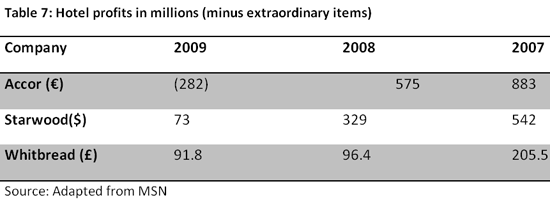
All three companies have reported lower profits over the course and Accor made a loss of €282m in 2009 due to the steep decline in revenue. Starwood’s profits would have been losses if not for the selling of assets. This indicates the sector is suffering again from a global slowdown.
5.3 Ratio Analysis
Ratio analysis is in important technique for turning quantities into meaningful and comparable ratios.
5.3.1 Liquidity ratio
Liquidity ratios include the current ratio and the quick ratio and calculate the ability to pay short-term debts: the larger the ratio the greater level of safety.

Each of the companies have current ratios of under 1. This means that if their debts had to be repaid immediately, they would be unable to do so. Such a low ratio has become more common throughout the sector due to companies relying on longer term credit agreements. The quick ratio excludes the calculation of inventories. Starwood were the only company to hold significant inventories during this period. Furthermore, the holding of goods is not fully relevant to hotel chains.
5.3.2 Profitability ratio
This ratio highlights the ability to generate earnings as compared to expenses and other costs over a period of time (Investopedia).
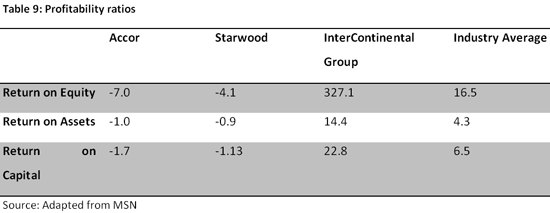
Return on equity is the amount of profit the company makes with the money invested by shareholders. The industry average for return on equity is 16.5. However, both Accor and Starwood are underperforming considerably at the current time. This is due to the lower levels of income and the higher price of shares. Return on assets is notably low for Accor and Starwood. This may be due to the selling off of many hotels and the movement towards franchising. Return on Capital considers the land and buildings owned. As the companies within the sector own large amounts of both, the return on capital is destined to be low.
6. Conclusion
In analysing the hospitality industry, it has become apparent that the major companies within the sector play a huge role in developing the environment. The large multinational firms dominate the market due to the size and reputation of the brands they possess.
Companies have gained their success through aggressive expansion strategies; the theme is common throughout the industry that acquisitions and mergers then introduce new brands in the hope of capturing new markets as the demands of consumers change. For companies to stay competitive within the sector they need to embrace changes such as the desire for high-quality budget accommodation and strive to conquer new geographical and demographic markets.
The recent trend to restructure operations, which has enabled companies within the sector to release capital and reduce burden, is positive and will continue into the future.
In conclusion, the future of the hotel sector will be bright. Regardless of economic conditions, the successful firms will continue to adapt and push the political, technological, economic and social boundaries.
7. References
Accot. (2009). Pess Relase- Quarterly Information. Paris: Accor.
Alexander, D. a. (2008). Financial Accounting: An International Introduction. Oxford: Prentice Hall.
Armstrong, J. (1981). The Value of Formal Planning for Strategic Decisions. Strategic Management Journal, 197-211.
Bowie, D. a. (2004). Hospitality Marketing. Oxford: Alsevier.
Brotherton, B. (2003). The international hospitality industry: structure, characteristics and issues. Oxford: Butterworth-Heinemann.
Choi, J.-G. (2003). Developing an economic indicator system (a forecasting technique) for the hotel industry. International Journal of Hospitality Management, 22(2), 147-159.
Clarke, A. a. (2007). International Hospitality Management: concepts and cases. Oxford: Elsevier.
Condon, S. (2010, September 8). Starwood signs deal to sell St. Regis Aspen. Retrieved 12 30, 2010, from Aspen times: http://www.aspentimes.com/article/20100908/NEWS/100909882
Daily Travel News. (2008, October 28). CHINA BECOMES STARWOOD’S SECOND LARGEST HOTEL MARKET BEHIND U.S. Retrieved 12 28, 2011, from Travelio: http://www.travelio.net/china-becomes-starwoods-second-largest-hotel-market-behind-us.html
DUNNING, J. M. (1981). The Eclectic Theory of International Production: A case study of the international Hotel Industry. Managerial and Decision Economics.
Go, F. G. (1992). The international hospitality industry and public policy. In R. O. Teare, International Hospitality Management (p. 36). New York: John Wiley & Sons.
Hayes, D. a. (2010). Revenue Management for the Hospitality Industry. UK: John Wiley & Sons.
Hotel Management Asia. (2010, April 07). Starwood to expand India portfolio 60% by 2013. Retrieved December 31, 2010, from Hotel Management Asia: http://hma.hotelworldasia.com/content/starwood-expand-india-portfolio-60-2013
Investopedia. (n.d.). Profitability Ratios. Retrieved January 1, 2011, from Investopedia: http://www.investopedia.com/terms/p/profitabilityratios.asp
Keegan, W. (1974). Multinational Scanning: A Study of the Information Sources Utilized by Headquarters Executives in Multinational Companies. Administrative Science Quarterly, 411-421.
Knowles, T. (1998). Hospitality Management. New York: Addison Wesley Longman.
Langston, J. (2008, 6 20). Revenue rises 9% in budget hotel sector. Travel Trade Gazette UK & Ireland, pp. 13-15.
Markowitz, H. (1959). Portfolio Selection, Efficient Diversification of Investments. New York: John Wiley and Sons.
Maslow, A. (1943). A Theory of Human Motivation. Psychological Review, 370-396.
Mintel. (2005). Luxury and Tailor-made Holidays. Retrieved from Mintel.
Mintel. (2010). Influential Factors When Choosing a Hotel. Mintel.
Mintel. (2010, December). Luxury Holidays – UK – June 2010. Retrieved 12 28, 2010, from Mintel: http://academic.mintel.com/
Mintel. (2010, May). Travel and Tourism – US – May 2010. Retrieved 12 29, 2010
MSN. (2010). Whitbread PLC: Financial Statement. Retrieved December 31, 2010, from MSN Money.
Olsen, M. W. (1998). Mangement in the Hospitality Industry. New York: John Wiley & Sons.
Porter, A. A. (2002). An Interview with Michael Porter. The Academy of MAnagement Executive, 43-52.
Reuland, R. C. (1985). Research in the field of hospitality. International Journal of Hospitality Management, 141-146.
Sharpe, J. L. (1990). Directions for the ’90s: Lessons from Japan . Cornell Hotel and Restraunt Administration Quarterly.
Starwood. (2009). Company overview. Starwood.
Thomas, D. (2007, 10 30). UK tourism worth £20b more than official estimates, says BHA. Retrieved 10 20, 2010, from Caterersearch.com: http://www.caterersearch.com/Articles/2007/10/30/316976/uk-tourism-worth-20b-more-than-official-estimates-says-bha.htm
Van Assen, M. V. (2008). Key management models. Prentice Hall.
Walker, J. (1996). Introduction to Hospitality. New Jersey: Pearson Prentice Hall.
Yahoo. (2010, February 25). Form 10-K for STARWOOD HOTEL & RESORTS WORLDWIDE INC. Retrieved 12 31, 2010, from Yahoo Finance: http://biz.yahoo.com/e/100225/hot10-k.html
8. Appendices
